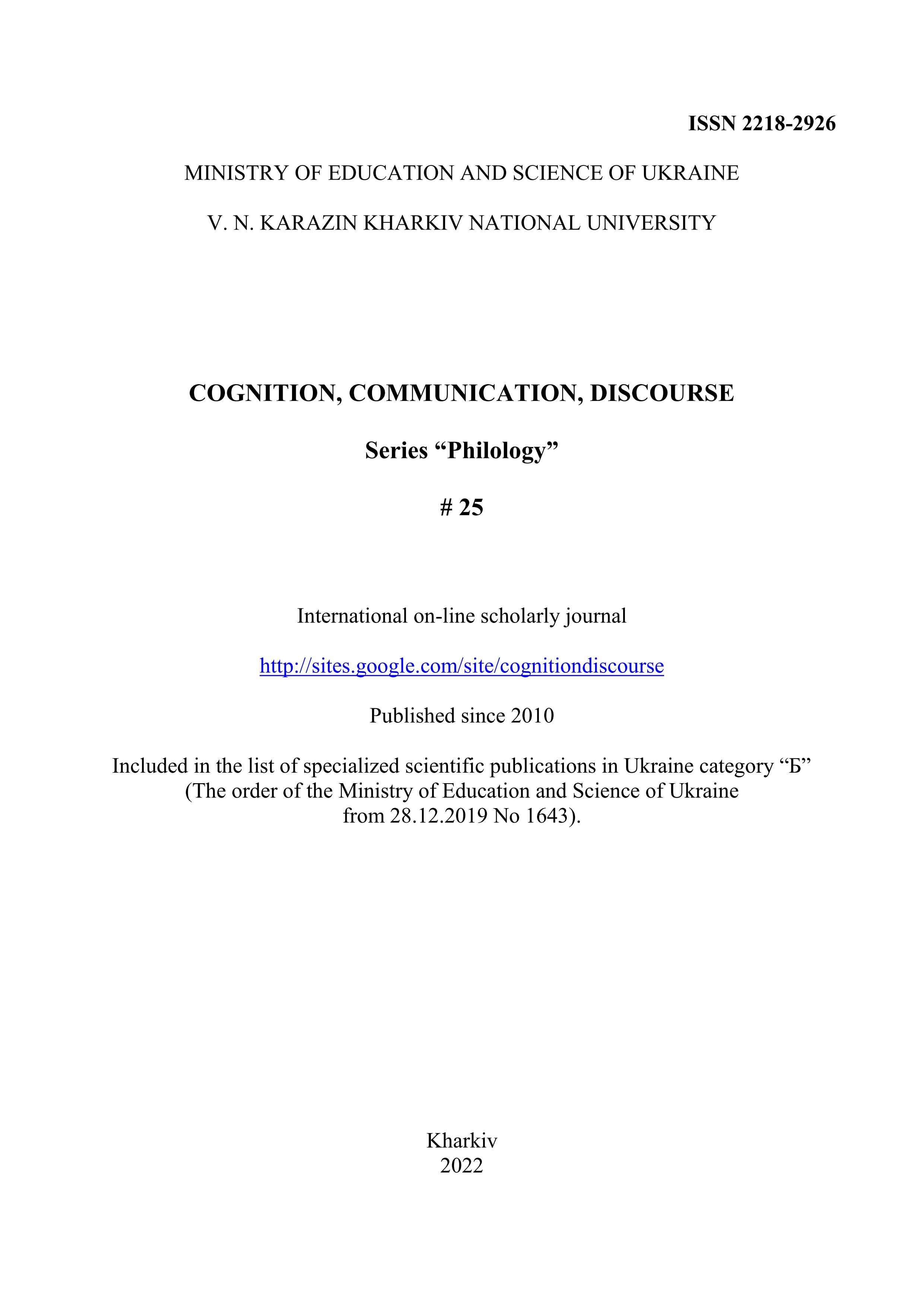Американські соціальні медіа про російсько-українську війну: мультимодальний аналіз
Анотація
Це дослідження зосереджено на політичному наративі про російсько-українську війну в американських соціальних медіа. Воно має на меті дослідити типи і конфігурацію мультимодальних семіотичних ресурсів, які використовуються для представлення подій цієї війни та моделюють їх сприйняття аудиторією, насамперед американською, у соціальних мережах, зокрема, Telegram-каналі The New York Times, що висвітлює російське військове вторгнення 2022 року. Які семіотичні ресурси використовують американські соціальні медіа для побудови наративу про війну? Які формати постів переважають; як вони розгортають інформацію про російсько-українську війну та конструюють її сприйняття: концепти війни, України як жертви агресії та борця за незалежність, Росії як держави-терориста та їхніх союзників і противників? Теоретично це дослідження базується на когнітивно-семіотичному та мультимодальному підходах у політичній лінгвістиці. У політичному медіа-наративі оповідання формує сприйняття реалій війни: воно формує та переформатує читацьку інтерпретацію світу, надає конотації фактам і подіям. Мультимодальний наратив включає різні семіотичні ресурси – вербальні, графічні, аудіальні та кінематографічні (у відео). Конфігурація цих різнорідних знаків у пості конкретного Telegram-каналу визначає його вплив як переважно раціональний або емоційний. Отримані дані показують, що для Telegram-каналу The New York Times характерні такі формати постів: зображення, за яким йде текст і посилання на інший сайт (найчастіший); галерея (галерея зображень) і цитата (цитата із заголовком джерела/автора) (рідше); рідковживані відео та аудіо. Вони служать для того, щоб підкреслити, деталізувати та розширити інформацію в пості. Дослідження доводить, що Telegram пости разом із емодзі-реакціями користувачів є специфічним інтерактивним жанром мультимодального політичного дискурсу. Емодзі реалізують як прагматичну, так і когнітивну функції: з одного боку, вони є ефективними інструментами для вимірювання реакції користувачів; з іншого, вони сприяють формуванню смислу, оцінюючи та висвітлюючи описані концепції. Домінування раціональної та перевіреної інформації в Telegram-каналі The New York Times створює правдивий образ геноцидної ВІЙНИ Росії проти України та дає справедливу оцінку пов’язаних концептів.
Завантаження
Посилання
Berger, J. (2016). Invisible influence: The hidden forces that shape behavior. New York, London, Toronto, etc.: Simon & Schuster Paperbacks.
Crying face (n.d.). Emojipedia. Retrieved from https://emojipedia.org/crying-face/
Dijk, T. A. van (2008). Discourse and context: A sociocognitive approach. New York, NY: Cambridge University Press.
Divjak, D., Milin, P., & Medimorec, S. (2020). Construal in language: A visual-world approach to the effects of linguistic alternations on event perception and conception. Cognitive Linguistics, 31(1), 37-72. https://doi.org/10.1515/cog-2018-0103
Groth, S. (2019). Political narratives / narrations of the political: An introduction. Narrative Culture, 6(1), 1-20. https://doi.org/10.13110/narrcult.6.1.0001
Herasimenka, A., Bright, J., Knuutila, A., & Howard, P.N. (2022). Misinformation and professional news on largely unmoderated platforms: The case of Telegram. Journal of information technology and politics, 1-15. https://doi.org/10.1080/19331681.2022.2076272
Herrero-Solana, V., & Castro-Castro, C. (2022). Telegram channels and bots: A ranking of media outlets based in Spain. Societies, 12(6), 164. https://doi.org/10.3390/soc12060164
How we verify our reporting on the Ukraine war (2022, March 11). The New York Times. Retrieved from https://www.nytimes.com/2022/03/11/world/europe/ukraine-war-journalism.html?action
Kress, G. (2010). Multimodality: A social semiotic approach to contemporary communication. London & New York: Routledge.
Krysanova, T. (2019). Constructing negative emotions in cinematic discourse: a cognitive-pragmatic perspective. Cognition, communication, discourse, 19, 55-77. https://doi.org/10.26565/2218-2926-2019-19-04
Lakoff, G., & Turner, M. (1989). More than cool reason. A field guide to poetic metaphor. Chicago and London: The University of Chicago Press.
Moschini, I., & Sindoni, M. G. (Eds.) (2022). Mediation and multimodal meaning making in digital environments. Routledge.
Neudert, L.-M., Howard, P., & Kollanyi, B. (2019). Sourcing and automation of political news and information during three European elections. Social Media + Society, 5(3). https://doi.org/10.1177/2056305119863147
O’Halloran, K. L. (2011). Multimodal analysis and digital technology. In A. Baldry, & E. Montagna (Eds.). Interdisciplinary Perspectives on Multimodality: Theory and Practice (pp. 1-26). Campobasso: Palladino.
Post Formats (n.d.). Retrieved from https://developer.wordpress.org/themes/functionality/post-formats/
Red Heart (n.d.). Emojipedia. Retrieved from https://emojipedia.org/red-heart/
Shenhav, S. R. (2006). Political narratives and political reality. International Political Science Review, 27(3), 245-262. https://doi.org/10.1177/0192512106064474
Shevchenko, I., & Gutorov, V. (2019). A cognitive-pragmatic perspective on apologies in English and Ukrainian discourse. Lege artis. Language yesterday, today, tomorrow. The journal of University of SS Cyril and Methodius in Trnava, IV (2), 301-341.
Thinking face (n.d.). Emojipedia. Retrieved from https://emojipedia.org/thinking-face/
Thumbs Down (n.d.). Emojipedia. Retrieved from https://emojipedia.org/search/?q=thumbs-down
Thumbs Up (n.d.). Emojipedia. Retrieved from https://emojipedia.org/search/?q=thumbs-up
Zhabotynska, S., & Ryzhova, O. (2022). Ukraine and the West in pro-Russia Chinese media: A methodology for the analysis of multimodal political narratives. Cognition, communication, discourse, 24, 115-139. https://doi.org/10.26565/2218-2926-2022-24-09
Zhabotynska, S., & Slyvka, N. (2020). Emotive speech acts and their discourse modifications in the literary text. Discourse and Interaction, 13(1), 113-136. https://doi.org/10.5817/DI2020-1-113
Авторське право (c) 2022 Ірина Шевченко

Цю роботу ліцензовано за Міжнародня ліцензія Creative Commons Attribution-NonCommercial-NoDerivatives 4.0.
Автори, які публікуються у цьому журналі, погоджуються з наступними умовами:
Автори залишають за собою право на авторство своєї роботи та передають журналу право першої публікації цієї роботи на умовах ліцензії Creative Commons Attribution License (CC BY), яка дозволяє іншим особам вільно розповсюджувати опубліковану роботу з обов'язковим посиланням на авторів оригінальної роботи та першу публікацію роботи у цьому журналі.
Автори мають право укладати самостійні додаткові угоди щодо неексклюзивного розповсюдження роботи у тому вигляді, в якому вона була опублікована цим журналом (наприклад, розміщувати роботу в електронному сховищі установи або публікувати у складі монографії), за умови збереження посилання на першу публікацію роботи у цьому журналі.
Політика журналу дозволяє і заохочує розміщення авторами в мережі Інтернет (наприклад, у сховищах установ або на особистих веб-сайтах) рукопису роботи, як до подання цього рукопису до редакції, так і під час його редакційного опрацювання, оскільки це сприяє виникненню продуктивної наукової дискусії та позитивно позначається на оперативності та динаміці цитування опублікованої роботи (див. The Effect of Open Access).




